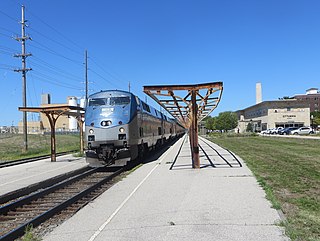
Ottumwa station is an Amtrak intercity train station in Ottumwa, Iowa, United States. The station was originally built by the Chicago, Burlington and Quincy Railroad, and has been listed as Burlington Depot by the National Register of Historic Places since November 26, 2008. It became a contributing property in the Historic Railroad District in 2011.

The Atchison, Topeka and Santa Fe Passenger and Freight Complex is a nationally recognized historic district located in Fort Madison, Iowa, United States. It was listed on the National Register of Historic Places in 1992. At the time of its nomination it contained three resources, all of which are contributing buildings. The buildings were constructed over a 24-year time period, and reflect the styles that were popular when they were built. The facility currently houses a local history museum, and after renovations a portion of it was converted back to a passenger train depot for Amtrak, which opened on December 15, 2021.

Chicago, Milwaukee, St. Paul and Pacific Depot – Delmar is a historic building located in Delmar, Iowa, United States. It is listed on the National Register of Historic Places.

Columbia station is a historic train station and headquarters of Columbia Transit located in Columbia, Missouri. The building was constructed in 1909 as the terminus of the Columbia Branch of the Wabash Railroad. It is a one-story, H plan, Tudor Revival style building constructed of locally quarried rock faced ashlar cut stone. In 2007, the building underwent renovation and restoration and was expanded to accommodate offices for Columbia's public transportation. The project, costing over $2.5 million, was intended to make the station a multi-model transportation center. It was certified at the LEED Silver Level, meaning it meets national standards for energy efficiency and sustainable construction. The station is the busiest bus stop in Columbia and served as a pickup point for Megabus until September of 2015.

The Burlington, Cedar Rapids and Northern Railway (BCR&N) was a railroad that operated in the United States from 1876 to 1903. It was formed to take over the operations of the bankrupt Burlington, Cedar Rapids and Minnesota Railway, which was, in turn, the result of merging several predecessor lines, the construction of which began in 1869. The corporate headquarters were in Cedar Rapids, Iowa, and it had operations in Iowa and in Minnesota. It was succeeded by the Chicago, Rock Island and Pacific Railway.

Wabash Combination Depot-Moravia, now known as the Wabash Depot Museum, is an historic train station located in Moravia, Iowa, United States. It is believed to be one of the two standard-plan wooden Wabash combination freight and passenger depots that remain in Iowa. Completed in 1903, it served the Wabash Railroad. The Queen Anne style building is an example of the rural combination station plan. The plan combined all railroad services from passengers to freight in one building. The museum features railroad artifacts, an operational model train layout and a restored railroad section car. The building was listed on the National Register of Historic Places in 1999 as a part of the Advent & Development of Railroads in Iowa MPS.
The Chicago and North Western Passenger Depot is a historic building located in Wall Lake, Iowa, United States. Wall Lake was served by both the Chicago & North Western Railroad and the Illinois Central Railroad, which gave it a significant rail presence from the 1880s until World War II. The C&NW depot is an example of a combination station plan. The plan combined both passenger and freight services in one building. They were commonly used during the heyday of railroad growth round the turn of the 20th century. However, the old Wall Lake C&NW depot was moved and used for freight. What would have been the freight room was used here for a lunchroom. C&NW had three standard combination depot plans that have been attributed to the prominent Chicago architectural firm of Frost & Granger. The Wall Lake depot was the largest of the three as it incorporated a women's waiting room, but it was actually 9 feet (2.7 m) shorter than the general plan because freight was processed in another facility. The depot was built in 1899 by A.H. Carter & Co. of Cedar Rapids, Iowa as a replacement depot. The single-story frame structure is the only building used as a depot that remains in town. It was listed on the National Register of Historic Places in 2003.

Chelsea station is a disused railroad depot located at 150 Jackson Street in Chelsea, Michigan. It was designated a Michigan State Historic Site in 1986 and listed on the National Register of Historic Places in 2010 as Michigan Central Railroad Chelsea Depot. The depot is the only known Michigan example designed by the well known Detroit architectural firm of Mason and Rice.

Keokuk Union Depot is a historic train station on the west bank of the Mississippi River near downtown Keokuk, Iowa, United States. It was built from 1890 to 1891, and it was listed on the National Register of Historic Places in 2013.

The Chicago, Milwaukee & St. Paul Depot-Jefferson, also known simply as the Milwaukee Depot is an historic building located in Jefferson, Iowa, United States. The rail line that this station served was built by the Wabash, St. Louis and Pacific Railway in either 1882 or 1883. It was part of the 500 miles (800 km) of track developed by Jay Gould in Iowa. Known as the High Bridge Route because of the height of the bridge over the Des Moines River, it was acquired by the Des Moines, Northern and Western Railroad in 1891. Four years later the Chicago, Milwaukee and St. Paul Railway acquired the line. The Milwaukee Road built this train station from their standard building plan between 1906 and 1909. It is almost identical to the station built in 1906 in Adel, Iowa. This passenger station replaced a combination passenger and freight depot that was moved and used solely as a freight depot. The Milwaukee Road discontinued passenger service in Jefferson in the early 1950s, and the depot continued as a freight office until 1980. The building was listed on the National Register of Historic Places in 1994.

Illinois Central Passenger Depot-Storm Lake, also known as the Storm Lake Depot, was an historic building located in Storm Lake, Iowa, United States. The Iowa Falls & Sioux City Railroad, an Illinois Central Railroad (IC) subsidiary, built the first tracks through town in 1870. They also built a two-story frame combination freight and passenger depot the same year. The present depot is a second generation IC structure built of brick. The building's architectural style is Prairie School with Tudor Revival elements in the dormer and canopy ends. It was designed by IC architect E.E. Bihl, and it is similar to the railroad's depots in Flossmoor, Illinois and Fort Dodge, Iowa. The new passenger depot was completed in August, 1915, and the old depot was re-purposed for a dedicated freight depot. It was torn down sometime before 1948. Passenger service remained high during the 1910s and 1920s, with the decline accelerating after World War II, and it ended all together in the late 1960s. While freight trains continue to use the IC's tracks, the depot has been abandoned. It was listed on the National Register of Historic Places in 1990. The Storm Lake Illinois Central depot was demolished on February 25, 2013.
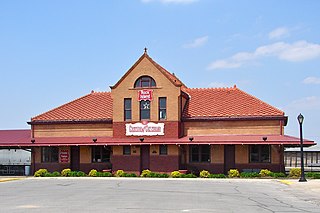
The Chicago, Rock Island & Pacific Railroad Depot, also known as the Rock Island Depot, is an historic building located in Atlantic, Iowa, United States. The Chicago, Rock Island & Pacific Railroad built the first tracks through the area in 1868. The city of Atlantic was founded at the time of the railroad construction. It grew to become the largest and the most significant community along the Rock Island lines between Des Moines and Council Bluffs. The present depot dates from 1898, and it is not a standard-plan depot for the railroad. The unusual design suggests it is the work of an architect, possibly from Chicago. It was built during a prosperous period for the railroad when it was able to replace its facilities along its mainline. The express freight and baggage building attached to the depot was built at the same time. The passenger depot replaced a frame combination passenger and freight depot a block away.
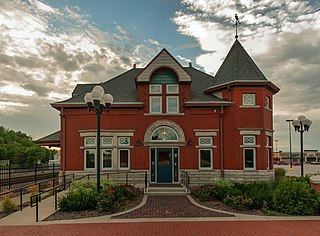
The Chicago & Northwestern Passenger Depot and Baggage Room-Carroll, also known as the Carroll Depot is a historic building located in Carroll, Iowa, United States. It is an example of a replacement station built along its Iowa mainline by the Chicago and North Western Railway (CNW) in 1896. It replaced a two-story, frame, combination station that was first built in 1867 by its predecessor line, the Cedar Rapids and Missouri River Railroad. That building had experienced two fires. The CNW had built two branch lines from Carroll in 1877 and 1880, which increased business and necessitated a larger depot. The Carroll Express Building was also built across the street for further railroad use. A separate wooden freight house had been built in 1888. Chicago architect Charles Sumner Frost designed this station in the Romanesque Revival style. The baggage room is separated from the depot by a breezeway. Frost designed at least 15 stations for the CNW in Iowa and Nebraska and another 14 in the Chicago area. The building represents the prosperity of the line during the Golden Age of Railroads.

The Rock Island Passenger Depot is a historic building located in Oskaloosa, Iowa, United States. The Chicago, Rock Island & Pacific Railroad arrived in town in 1876, and they built a frame combination depot on the north side of the tracks. This depot replaced the original one in 1888 on the south side of the tracks, and it served ten passenger trains a day. A separate freight depot was built to the east. President Theodore Roosevelt stopped here when he came to dedicate the new Y.M.C.A. in 1903. The freight and passenger depots were combined into a single facility once again in 1930, utilizing the passenger depot. The depot was officially abandoned in 1973. It was listed on the National Register of Historic Places in 1989. The building now houses a pub.
The Chicago, Milwaukee, St. Paul and Pacific Railroad Company Depot, also known as Fayette Depot, is a historic building located northeast of Fayette, Iowa, United States. The Chicago, Milwaukee, St. Paul and Pacific Railroad reached Fayette in 1874 and this depot was built at that time to serve as a combination passenger and freight station. It was hoped that a rail station in centrally located Fayette would mean the city would become the county seat for Fayette County, but West Union to the north got the designation instead. The single-story frame structure has a bay window to give the telegraph operator a view up and down the tracks. An addition was constructed in 1913. It served as the community's rail depot well into the 20th century. It was moved to its current location in the Volga River State Recreation Area. The building was listed on the National Register of Historic Places in 1978.
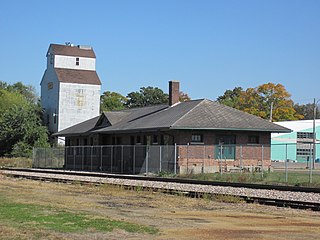
Illinois Central Combination Depot-Ackley is a historic building located in Ackley, Iowa, United States. The Dubuque & Sioux City Railroad, an affiliate of the Illinois Central Railroad (IC), laid the first rail track to Iowa Falls in 1865. Two years later the Iowa Falls & Sioux City Railroad, another IC affiliate, continued construction of the line to the west, and it reached Sioux City by 1870. They built a plain, two-story frame depot to serve Ackley. From the 1890s to the 1920s the IC replaced its first generation stations with new brick structures. IC architect J.H. Schott designed the new depot at Ackley, and it was built by Coomer & Small Construction Company of Sioux City. The long and low single-story brick building exhibits influences from the Prairie School and the Tudor Revival style. A combination depot is one that incorporates passenger and freight services in the same building. It was also an island depot, meaning that it sat in the middle of the tracks. It was one of the last replacement depots the IC built before the Great Depression. The building was listed on the National Register of Historic Places in 1990.
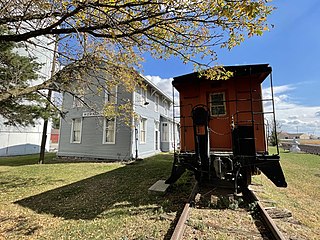
The Chicago, Milwaukee, St. Paul & Pacific Combination Depot-Hornick, also known as the Hornick Depot, is a historic building located in Hornick, Iowa, United States. The town was patted by the Chicago, Milwaukee, St. Paul & Pacific Railroad's land company when the railroad created a branch line from Manilla, Iowa to Sioux City. Completed in 1887, the railroad built this two-story frame structure to serve as its passenger and freight depot. It is one of six such depots that remain in Iowa, and the best preserved. These buildings were built from a standard design used by the railroad. The two-story stations included living quarters for the station manager because the towns had yet to develop when the depot was built. This was an island depot, with freight loaded on the north side and passengers boarded on the south. Decorative elements on this depot include lathe-turned wooden finials, angled wooden brackets, and bracketed door and window hoods. Passenger service ended in the 1950s, and grain was loaded here until 1980 when the Milwaukee Road abandoned the Sioux City branch line. The building was listed on the National Register of Historic Places in 1990. It has been converted into a local history museum.

Rawlins station is a former train station in Rawlins, Wyoming. It was served by the Union Pacific Railroad from its 1901 construction to 1971, and Amtrak from 1971–1983 and 1991–1997. It was added to the National Register of Historic Places in 1993, as the Union Pacific Railroad Depot.
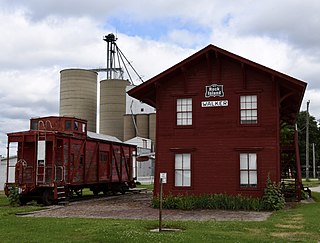
Walker Station is a historic building located in Walker, Iowa, United States. The two-story frame building with bracketed eaves was completed in 1873 along the Burlington, Cedar Rapids, and Minnesota Railway tracks. The depot also served its successor railroads: the Burlington, Cedar Rapids and Northern, and the Chicago, Rock Island and Pacific. Typical of many railroad towns in the Midwest, this is the first building that was built here and the town grew up around it. It is an example of a combination depot that was used for both passenger and freight usage in smaller communities. Because it has a ground level brick platform, service here was primary passenger and light freight service. A higher level of freight service would have required a raised platform.

The Milwaukee and St. Paul Railway Combination Depot is a historic building located in Decorah, Iowa, United States. After the Milwaukee and St. Paul Railroad, later the Chicago, Milwaukee, St. Paul and Pacific Railroad, choose a different route for their north–south mainline, community leaders convinced them to build a spur to Decorah. This would open the town to larger markets to ship the products produced there. The tracks were completed in 1869, and a boxcar served as the first depot. That same year this single-story, wood-frame structure with Greek Revival features was completed south of the central business district. It served as a combination depot, servicing both passengers and freight. After the arrival of the Chicago, Rock Island and Pacific Railroad in 1884 the Milwaukee Road started to plan a new passenger depot in Decorah. It was completed on the east end of the main commercial street in 1888. When it opened, this building continued to serve as a freight depot. Over the years its platforms were shortened, and sometime between the 1930s and the 1950s, the southwest end of the building was shortened. The Milwaukee Road abandoned the depot in 1971, and the tracks that flanked the building were removed the same year. The former depot itself was renovated for non-railroad use. This is believed to be a rare extant example of a wooden combination depot in Iowa. The building was listed on the National Register of Historic Places in 2016.





















